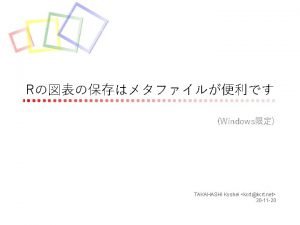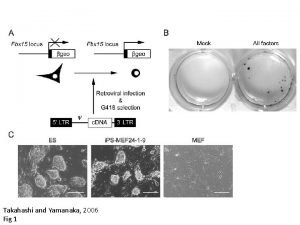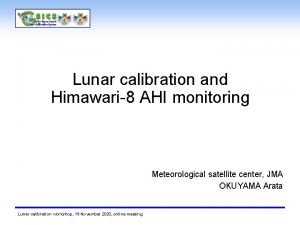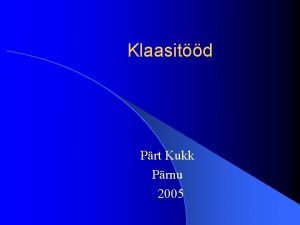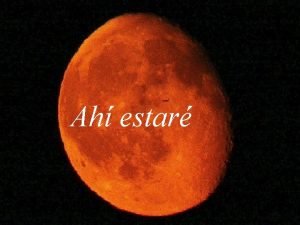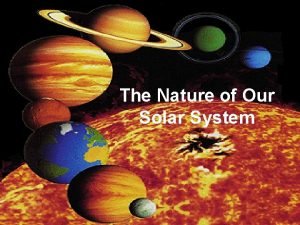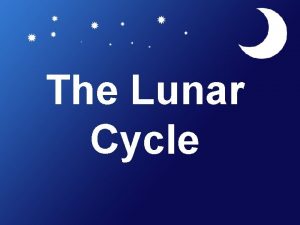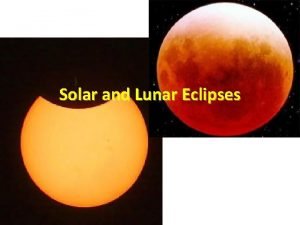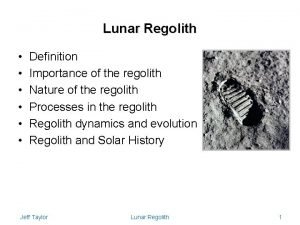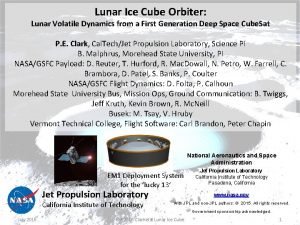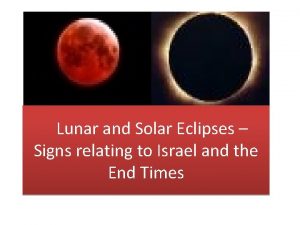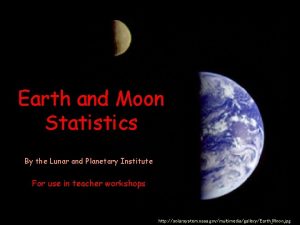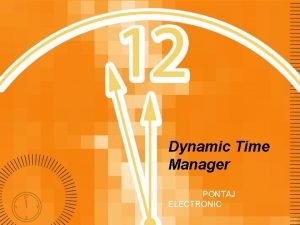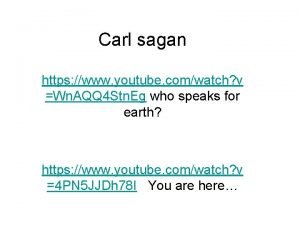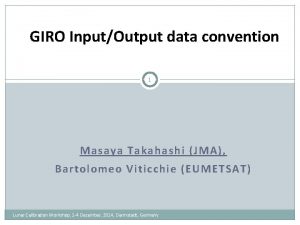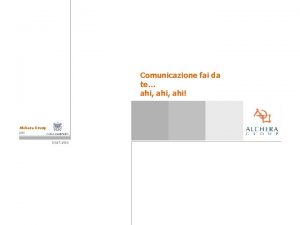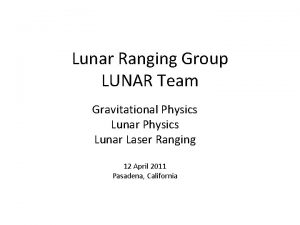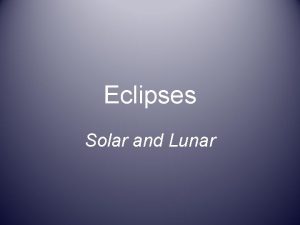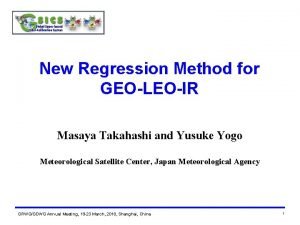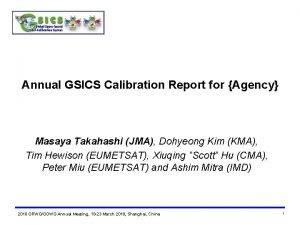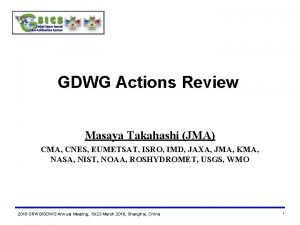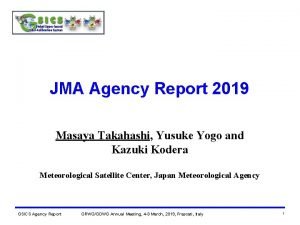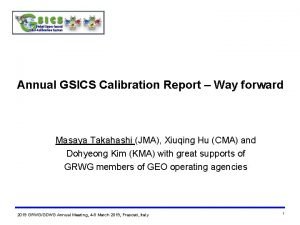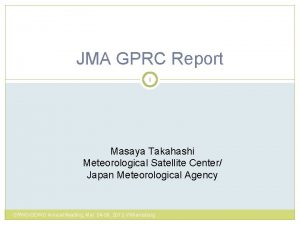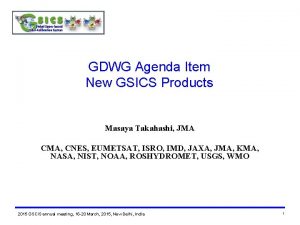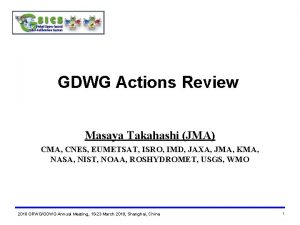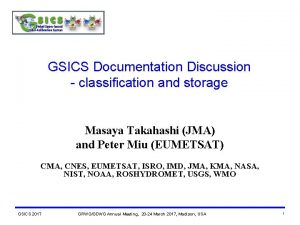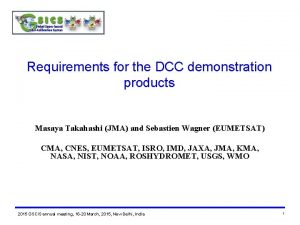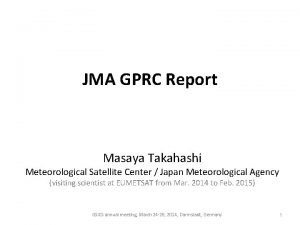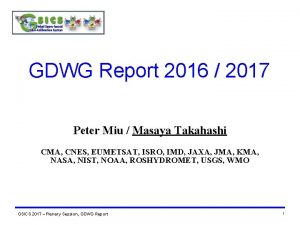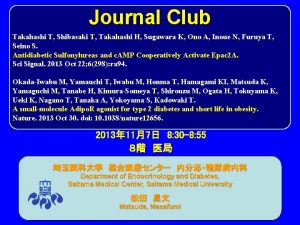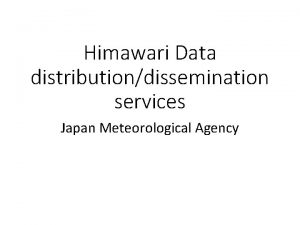Lunar Data Preparation for Himawari89 AHI Masaya Takahashi




















![Typical Observation Schedule in 10 minutes Repeat Cycle 22 [sec] Blackbody Obs. 2 nd Typical Observation Schedule in 10 minutes Repeat Cycle 22 [sec] Blackbody Obs. 2 nd](https://slidetodoc.com/presentation_image_h/89a60c9bd561882a7fdab73a768be33f/image-21.jpg)







- Slides: 28

Lunar Data Preparation for Himawari-8/-9 AHI Masaya Takahashi Meteorological Satellite Center Japan Meteorological Agency 1 2 nd GSICS/CEOS Lunar Calibration Workshop, 13 -16 November, Xi’an, China

Contents 2 • Overview ‒ Mission Life Time, Sensor Configuration/Characteristics ‒ Himawari-8/-9 AHI Lunar Observation • Computation of Observed Lunar Irradiance ‒ Oversampling, Pixel IFo. V, Radiance Calculation, Moon Pixel Selection ‒ Preliminary Lunar Calibration Results • Summary and Future Plans 2 nd GSICS/CEOS Lunar Calibration Workshop, 13 -16 November, Xi’an, China

Mission Overview 3 • Himawari-8 – Advanced Himawari Imager (AHI): next-gen. GEO imager w/ 3 VIS, 3 NIR, 10 IR bands – Solar diffuser is equipped for VNIR calibration (but w/o SDSM) – Full-disk observation every 10 minutes + 5 regional observations every 2. 5/0. 5 minutes – Has been operational since July 2015, located at ~140. 7 E • Himawari-9 – Launched on 2 Nov. 2016, Located at ~140. 7 E, ~0. 1 degrees apart from Himawari-8 – 10 Mar. 2017: the satellite was put into in-orbit standby as back up for Himawari-8 – “Health Check” observations are periodically (~2 weeks, a few times / year) performed before the switchover in 2022 FY 2010 2015 2017 2 nd GSICS/CEOS Lunar Calibration Workshop, 13 -16 November, Xi’an, China 2020 2025 2029

Himawari-8/-9 AHI 4 AHI Band Configuration B 01 B 02 B 03 B 04 B 05 B 06 B 07 B 08 B 09 B 10 B 11 B 12 B 13 B 14 B 15 B 16 Central Wlen [μm] 0. 47 0. 51 0. 64 0. 86 1. 6 2. 3 Spatial Reso. [km] # of detectors 1 1 0. 5 1 2 2 3. 9 6. 2 6. 9 7. 3 8. 6 2 2 2 9. 6 10. 4 11. 2 12. 4 13. 3 2 2 2 676 1460 676 372 327 332 332 332 408 408 Spectral Response Functions of Himawari-8/AHI, GOES-16/ABI and Meteosat-10/SEVIRI Wavelength [μm] 2 nd GSICS/CEOS Lunar Calibration Workshop, 13 -16 November, Xi’an, China Wavelength [μm]

Himawari-8/-9 AHI Lunar Observation 5 • Lunar observation: based on the prediction of its position within AHI’s Field of Regard • Regional observation mode (1000 x 500 km for the earth scene) is used • 1 observation / 30 seconds • Just one scan to observe the Moon • All 6 VNIR bands (0. 47, 0. 51, 0. 64, 0. 86, 1. 6, 2. 3 µm) are used for GIRO Himawari-8/AHI (4 Mar. 2015 – 30 Oct. 2016) 26167 Obs. / 20 months Earth disk AHI Fo. R 2 nd GSICS/CEOS Lunar Calibration Workshop, 13 -16 November, Xi’an, China

Full Disk / Regional Observation in 10 minutes Repeat Cycle AHI Fo. R Region 4, 5: mainly used for landmark observation, but region 5 is also used for lunar observation Earth edge Lunar observations Band 5 (1. 6μm) Pre-defined area Flexible observation area Full Disk Observation every 10 min. (23 swaths) Region 1 2000 x 1000 km (NE Japan) Every 2. 5 min. Region 3 Region 5 Region 2 Region 4 1000 x 500 km 2000 x 1000 km 1000 x 1000 km 1000 x 500 km (Target Area) (Landmark Area) (SW Japan) Every 30 sec. Every 2. 5 min. Every 30 sec. 2 nd GSICS/CEOS Lunar Calibration Workshop, 13 -16 November, Xi’an, China

Himawari-8/AHI Lunar Observations 7 2 nd GSICS/CEOS Lunar Calibration Workshop, 13 -16 November, Xi’an, China

Oversampling, Pixel Solid Angle 8 • Oversampling factor – N-S IFo. V / N-S Sampling Distance – No E-W oversampling is assumed because E-W IFo. V < E-W Sampling Distance • Pixel solid angle – E-W Sampling Distance * N-S IFo. V • Both oversampling/Pixel IFo. V: assumed to be constant • Future plans – Revisit of the definition of oversampling factor and pixel solid angle ü Under-discussion within NOAA-JMA bilateral collaboration on ABI/AHI Cal/INR – Calculation of alternative factor (e. g. effective moon solid angle (Choi et al. 2016)) – Validation of the pre-launch determined IFo. V using on-orbit observation data 2 nd GSICS/CEOS Lunar Calibration Workshop, 13 -16 November, Xi’an, China

Radiance 9 • Level of image processing – Level 1 A/1. 0 equivalent data • Calibration used to convert DN to radiance – Quadratic calibration equation ü Quadratic term: pre-launch determined value ü Slope: solar diffuser / pre-launch determined value ü Offset: deep space observation (updated at each full-disk swath / each lunar obs. ) • Handling extraneous signals – Out-of-Filed Anomalous Response (OFAR, Griffith 2017) ü Appears in Band 1 -3 (0. 47, 0. 51 and 0. 64 μm) P. Griffith, 2017: Himawari 08 Out-of-Field Anomalous Response (OFAR), 8 th Asia/Oceania Meteorological Satellite Users’ Conference, 18 - 20 October 2017, Vladivostok, Russia. 2 nd GSICS/CEOS Lunar Calibration Workshop, 13 -16 November, Xi’an, China

Moon Pixel Selection 10 • Based on DC thresholds – Needs to discriminate the Moon and Out-of-Field Anomalous Response (Griffith 2017) – OFAR: blurring occurs in Bands 1 -3 (0. 47, 0. 51, 0. 64 μm) which use silicon detectors ü No effect in other bands which use Hg. Cd. Te detectors ü Appears west of the Moon under the current observation configuration ü GOES-R/ABI and GK-2 A/AMI are unaffected by OFAR Enhanced Himawari-8/AHI lunar observation image (color scale: 0. 1 – 30 % of reflectivity) Band 1 (0. 47 μm) Band 2 (0. 51 μm) Band 3 (0. 64 μm) Band 4 (0. 86 μm) 19 August 2016 2 nd GSICS/CEOS Lunar Calibration Workshop, 13 -16 November, Xi’an, China

Moon Pixel Selection using Connected-component Labeling 11 • DC threshold + Connected-component Labeling method is used – Connected-component Labeling method 1. Assign the same number (label) to adjacent pixels which exceed the threshold (e. g. DC=25) 2. Choose the label w/ the biggest # of pixels as the Moon pixels – Effectively distinct OFAR for positive lunar phase angles, but difficult for negative phase angles Labelled pixels Selected Moon pixels 2 nd GSICS/CEOS Lunar Calibration Workshop, 13 -16 November, Xi’an, China Phase angle: -28. 2 deg.

AHI lunar irradiance vs. GIRO Difference of lunar irradiance between the observation and GIRO [%] 13 • DC threshold (=25) + Connected-component Labeling approach for the Moon masking – Unexpected phase angle dependence exists – Further lower DC threshold (~20) should be ideally used – Nonlinearity in AHI ? - to be investigated Band 3 (0. 64 μm) ΔIrr (%) Band 3 (0. 64 μm) Color: lunar phase angle [deg] Lunar phase angle [deg] Notes: • Sub-sampled lunar observations (#439) are shown • ΔIrr is normalized by ΔIrr (t=0; 2015 -06 -08) • Calibration slope from solar diffuser obs. (mean of Mar-May 2015 results) is used for all the lunar obs. 2 nd GSICS/CEOS Lunar Calibration Workshop, 13 -16 November, Xi’an, China

Summary and Future Plans 14 � Himawari-8/-9 AHI lunar observation ‒ 6 VNIR bands (0. 47, 0. 51, 0. 64, 0. 86, 1. 6, 2. 3 μm) ‒ Available since March 2015 (Himawari-8) ‒ Himawari-9/AHI lunar observation: the quality is under checking � AHI lunar calibration ‒ Revisit of oversampling / pixel IFo. V is needed in collaboration w/ NOAA ‒ Moon pixel selection should be updated (e. g. use of further lower DC threshold and lunar shape fitting) ‒ Root cause of phase angle dependence in band 1 -3 needs to be investigated � Himawari-8/AHI lunar observation data for GLOD ‒ 500 -1000 lunar observation data are planned to be shared ‒ Contents (e. g. observed lunar irradiance) will be periodically updated 2 nd GSICS/CEOS Lunar Calibration Workshop, 13 -16 November, Xi’an, China

15 Thanks for your attention! 2 nd GSICS/CEOS Lunar Calibration Workshop, 13 -16 November, Xi’an, China

Time Series of ΔIrr of Himawari-8/AHI 16 Difference of lunar irradiance between the observation and GIRO [%] Ø Moon pixel selection • Larger DC threshold (=30) Ø Sensor degradation trend • Good agreements with other Cal/Val approaches 2 12 22 32 42 52 62 72 82 92 Phase angle [deg] Band 2 (0. 51μm) Band 3 (0. 64μm) Band 4 (0. 86μm) Band 5 (1. 6μm) Band 6 (2. 3μm) ΔIrr (%) Band 1 (0. 47μm) 2 nd GSICS/CEOS Lunar Calibration Workshop, 13 -16 November, Xi’an, China

Time Series of ΔIrr of Himawari-8/AHI 17 Difference of lunar irradiance between the observation and GIRO [%] Ø Moon pixel selection • Lower DC threshold (=25) + Connected-component labeling Ø Sensor degradation trend • Good agreements with other Cal/Val approaches 2 12 22 32 42 52 62 72 82 92 Phase angle [deg] Band 2 (0. 51μm) Band 3 (0. 64μm) Band 4 (0. 86μm) Band 5 (1. 6μm) Band 6 (2. 3μm) ΔIrr (%) Band 1 (0. 47μm) 2 nd GSICS/CEOS Lunar Calibration Workshop, 13 -16 November, Xi’an, China

Himawari-8/AHI lunar phase angle dependence in ΔIrr Good agreement with SEVIRI NIR 1. 6, but not with SEVIRI VIS 0. 6 18 ΔIrr (%) Moon pixel selection w/ larger DC threshold (~30) Band 1 (0. 47μm) Band 5 (1. 6μm) Band 3 (0. 64μm) Band 6 (2. 3μm) ΔIrr (%) Band 4 (0. 86μm) Band 2 (0. 51μm) Lunar phase angle [deg] MSG 1/SEVIRI VIS 0. 6 Lunar phase angle [deg] MSG 1/SEVIRI NIR 1. 6 Difference of lunar irradiance between the observation and GIRO [%] SEVIRI results from B. Viticchie at the Lunar Calibration Workshop in Dec. 2014 2 nd GSICS/CEOS Lunar Calibration Workshop, 13 -16 November, Xi’an, China

Himawari-8/AHI lunar phase angle dependence in ΔIrr Good agreement with SEVIRI NIR 1. 6, but not with SEVIRI VIS 0. 6 19 ΔIrr (%) Moon pixel selection w/ lower DC threshold (=25) + Connected-component labeling Band 1 (0. 47μm) Band 5 (1. 6μm) Band 3 (0. 64μm) Band 6 (2. 3μm) ΔIrr (%) Band 4 (0. 86μm) Band 2 (0. 51μm) Lunar phase angle [deg] MSG 1/SEVIRI VIS 0. 6 Lunar phase angle [deg] MSG 1/SEVIRI NIR 1. 6 Difference of lunar irradiance between the observation and GIRO [%] SEVIRI results from B. Viticchie at the Lunar Calibration Workshop in Dec. 2014 2 nd GSICS/CEOS Lunar Calibration Workshop, 13 -16 November, Xi’an, China

JMA geostationary satellites 20 GMS (Geostationary Meteorological Satellite) GMS-2 (Himawari) ⒸNASDA Jul 1977 (Himawari-2) ⒸNASDA Aug 1981 GMS-3 (Himawari-3) ⒸNASDA Aug 1984 GMS-4 (Himawari-4) ⒸNASDA Sep 1989 (GOES-9) GMS-5 Back-up operation of GMS-5 w/ GOES-9 by NOAA/NESDIS: 2003/05/222005/06/28 (Himawari-5) ⒸNASDA Mar 1995 MTSAT (Multi-functional Transport SATellite ) MTSAT-1 R (Himawari-6) MTSAT-2 (Himawari-7) Himawari-8 launched on 7 Oct. 2014 Operation started on 7 July 2015 ⒸSS/L Feb 2005 ⒸMELCO 2014 Feb 2006 2 nd GSICS/CEOS Lunar Calibration Workshop, 13 -16 November, Xi’an, China Himawari-9 2016 Satellite Operation period GMS 1978 – 1981 GMS-2 1981 – 1984 GMS-3 1984 – 1989 GMS-4 1989 – 1995 GMS-5 1995 – 2003 GOES-9 2003 – 2005 MTSAT-1 R 2005 – 2010 MTSAT-2 2010 – 2015 Himawari-8 2015 – 2022 Himawari-9 2022 – 2029 launched on 2 November 2016 Planned to be back up of Himawari-8 in March 2017

Advanced Himawari Imager (AHI) Spatial Central # of Levels Band Wavelength Resolution detectors of digital (*) count [bit] [μm] [km] 1 0. 47 1 676 (3) 11 2 0. 51 1 676 (3) 11 3 0. 64 0. 5 1460 (3) 11 4 0. 86 1 676 (6) 11 5 1. 6 2 372 (6) 11 6 2. 3 2 372 (6) 11 7 3. 9 2 332 (6) 14 8 6. 2 2 332 (6) 11 9 6. 9 2 332 (6) 11 10 7. 3 2 332 (6) 12 11 8. 6 2 332 (6) 12 12 9. 6 2 332 (6) 12 13 10. 4 2 408 (6) 12 14 11. 2 2 408 (6) 12 15 12. 4 2 408 (6) 12 16 13. 3 2 408 (6) 11 21 AHI Field of View Center (VNIR) ITT EXELIS(2013): AHI-8 EQUIPMENT MANUAL 2 CALIBRATION AND ALIGNMENT HANDBOOK Rev. J *Number of redundant detector columns per side 2 nd GSICS/CEOS Lunar Calibration Workshop, 13 -16 November, Xi’an, China
![Typical Observation Schedule in 10 minutes Repeat Cycle 22 sec Blackbody Obs 2 nd Typical Observation Schedule in 10 minutes Repeat Cycle 22 [sec] Blackbody Obs. 2 nd](https://slidetodoc.com/presentation_image_h/89a60c9bd561882a7fdab73a768be33f/image-21.jpg)
Typical Observation Schedule in 10 minutes Repeat Cycle 22 [sec] Blackbody Obs. 2 nd GSICS/CEOS Lunar Calibration Workshop, 13 -16 November, Xi’an, China Full Disk Region 1 (NE Japan) BB Obs. Region 2 (SW Japan) Space Look Region 3 (Target Area) Region 4 (Landmark Area) [sec] Region 5 (Landmark Area)

VIS/NIR on-board Calibration using Solar Diffuser (SD) 23 Ø Quadratic calibration equation in “L 1 A (L 1. 0) equivalent data” processing • qn: pre-launch test value • mn : – Pre-launch test value (until 7 June 2015) – Values based on solar diffuser (SD) observations (since 8 June 2015). SD observation is performed every 2 weeks • Csp: updated by deep space observation at each Full-disk swath a a 2 nd GSICS/CEOS Lunar Calibration Workshop, 13 -16 November, Xi’an, China Robsn: Observed radiance CAn: Raw digital count Cspn: Deep space raw digital count qn, mn: Coefficients n: Detector ID r : Scan mirror reflection coef. q, f : Incidence angle to SM

VNIR Calibration Slopes derived from Solar Diffuser (SD) observations 24 • SD observation: performed twice / month • June 2015: VNIR calibration slopes in L 1 data were updated using Mar-May 2015 SD obs. • ~0. 5% degradation trends in Band 1 -4 (no SD degradation is assumed) Time series of inverse of detector-averaged calibration slope from SD observations Band 1 (0. 47μm) Band 2 (0. 51μm) Band 4 (0. 86μm) Band 3 (0. 64 μm) Band 6 (2. 3 μm) Band 5 (1. 6μm) 2 nd GSICS/CEOS Lunar Calibration Workshop, 13 -16 November, Xi’an, China

Validation of On-board Calibration Slope 25 • ~0. 5%/year of degradation trends in Band 1 -4 • ~6% bias for Band 5, ~4 % bias for Band 6 based on ray-matching validation Time series of ratios between Himawari-8/AHI observations and reference values Band 1 (0. 47μm) Band 2 (0. 51μm) Band 3 (0. 64μm) Band 5 (1. 6μm) Band 6 (2. 3μm) Updates of Cal. slope Band 4 (0. 86μm) 2 nd GSICS/CEOS Lunar Calibration Workshop, 13 -16 November, Xi’an, China Error bar: stdv. of slopes

Validation of On-board Calibration Method 1) Vicarious Calibration using RT Simulation 26 • Comparison of observed and simulated radiance for multiple targets (collaboration research with the August 2015 University of Tokyo and JAXA/EORC [Prof. Nakajima]) ‒ Cloud-free ocean (rayleigh scattering) , liquid water cloud, *cloud-free land *deep convective cloud • Radiative transfer calculation: ‒ RSTAR (Nakajima and Tanaka [1986, 1988]) Simulated reflectivity • Targets: • Input data: Independent from GEO data ‒ JMA Re-Analysis atmos. profiles (JRA-55/JCDAS) ‒ Aerosol/Cloud optical thickness retrieved from MODIS Observed reflectivity L 1 B (M[O, Y]D 02 SSH) ‒ MODIS BRDF (MCD 43 C 2) for land target ‒ Aura/OMI total column ozone, … *Not implemented for Himawari-8/-9 AHI as of June 2017 2 nd GSICS/CEOS Lunar Calibration Workshop, 13 -16 November, Xi’an, China

Validation of On-board Calibration Method 2) Ray-matching with S-NPP/VIIRS 27 • Inter-calibration based on AHI-VIIRS collocation (Quasi-SNO) ‒ Calibration target: cloud pixels ‒ Low radiance scene (e. g. cloud-free ocean) : not used • Spectral Band Adjustment Factor (SBAF) accounting for the spectral mismatch ‒ Band 1 -5: from NASA Langley SBAF based on SCHIAMACHY (http: //cloudsgate 2. larc. nasa. gov/SBAF) ‒ Band 6: computed using RSTAR simulation Band 1 (0. 47 μm) Band 3 (0. 64 μm) 2 nd GSICS/CEOS Lunar Calibration Workshop, 13 -16 November, Xi’an, China Band 5 (1. 6 μm) Stats from 17 to 31 Oct. 2016

Comparison of VNIR Calibration between AHI-8/-9 28 • Results for AHI-8/-9 vicarious calibration, ray-matching and GEO-GEO comparison – Converted to (AHI-9/AHI-8 – 1) x 100 [%] • Good agreements among the three (AHI-9/AHI-8 -1) x 100 [%] validation methods – Band 1: AHI-9 is 4 -6% brighter than AHI-8 – Band 2 -4, 6: AHI-8/-9 diffs. are within 2% – Band 5: AHI-9 is ~6% darker than AHI-8 • Notes on calibration slope – AHI-8: derived from solar diffuser obs. in Mar-May 2015 – AHI-9: pre-launch determined value Ø Could cause AHI-8/-9 discrepancies in 0. 47 the validation 2 nd GSICS/CEOS Lunar Calibration Workshop, 13 -16 November, Xi’an, China 0. 51 0. 64 0. 86 1. 6 2. 3 [μm] Observation data: 14 -28 Feb. 2017

AHI-8 vs. VIIRS direct comparison (ray-matching) 29 Ø AHI Band 1 (0. 47 µm) • Brighter VIIRS at dark scenes 2 nd GSICS/CEOS Lunar Calibration Workshop, 13 -16 November, Xi’an, China AHI-8 Band 1 (0. 47 μm) vs. VIIRS M 03 (0. 46 µm)
 Takahashi kyohei
Takahashi kyohei Takahashi yamanaka 2006
Takahashi yamanaka 2006 Hayao miyazaki and walt disney
Hayao miyazaki and walt disney Torrance memorial cardiac rehab
Torrance memorial cardiac rehab Maile takahashi
Maile takahashi Unipolygrafia laite
Unipolygrafia laite Automatic positive airway pressure
Automatic positive airway pressure Ahi evran kampüs kart
Ahi evran kampüs kart Hay momentos de la vida
Hay momentos de la vida Frases en sentido connotativo
Frases en sentido connotativo Canto 1 purgatorio
Canto 1 purgatorio Ahi momentos en la vida
Ahi momentos en la vida Lunar
Lunar Klaasi sulatamine
Klaasi sulatamine No sé
No sé Que es adverbio de cantidad
Que es adverbio de cantidad Dicen que la vida son momentos
Dicen que la vida son momentos Ay momentos en la vida
Ay momentos en la vida Data preparation and basic data analysis
Data preparation and basic data analysis Data preparation for data mining
Data preparation for data mining Difference between solar and lunar eclipse
Difference between solar and lunar eclipse Whats the lunar cycle
Whats the lunar cycle Differentiate between lunar eclipse and solar eclipse
Differentiate between lunar eclipse and solar eclipse Regolith def
Regolith def Lunar ice cube
Lunar ice cube Lunar eclipse israel
Lunar eclipse israel Moon stats
Moon stats Pontaj electronic
Pontaj electronic Carl sagan lunar eclipse
Carl sagan lunar eclipse
